« Looking Up | Main | Artifacts »
August 23, 2004
Squinting
 Well in the past few weeks, I've been absorbing a lot about the night sky and ways of observing it. As momentum would have it, I ordered a 6" Newtonion refractor (Orion Skyview Pro 6LT) that arrived last week, and I've been totally blown away. But, you see, that's "blown away" in the Geek sense, where seeing a teeny blotch of stars arranged in an eyepiece gives you a thrill but probably gives your average passerby that tepid so-what feeling. So anyway, you might want to keep that in mind as I blither on here.
Well in the past few weeks, I've been absorbing a lot about the night sky and ways of observing it. As momentum would have it, I ordered a 6" Newtonion refractor (Orion Skyview Pro 6LT) that arrived last week, and I've been totally blown away. But, you see, that's "blown away" in the Geek sense, where seeing a teeny blotch of stars arranged in an eyepiece gives you a thrill but probably gives your average passerby that tepid so-what feeling. So anyway, you might want to keep that in mind as I blither on here.
The telescope was dropped off last Tuesday, but I didn't start construction until we got back from our meeting around 10 o'clock that night. I had some fun keeping the kids up late and bringing out the parts one by one and asking them what they thought each one was for. The tripod mount on the scope was a lot heftier than I had imagined, which is good. I was hoping to have a setup that would let me do guided photography through the telescope, and so the sturdier the better. It's also an equatorial mount, which means that once you line it up with the celestial pole, the telescope can be rotated simply on one axis to follow the stars across the sky.
When I had everything put together and balanced, I set up on the sidewalk outside the front door, with the cement factory lights blazing away. I didn't care at this point. I just wanted to see something. After checking focus on some generic stars in the Milky Way, I caught sight of the Pleiades rising in the east. So I swung the telescope over and drew a bead on it. It was strange seeing that close group of stars splayed wide open, burning bright and hot. After taking turns checking out The Sistas with Amanda, I decided to try for the Andromeda Galaxy. I took a bead off Cassiopeia and saw the dim smudge that I needed to aim for. And then I started making an idiot out of myself yapping about how cool it was. It's a huge soft disc with a bright nucleus, and off to the side is one of its companion galaxies. When we get the chance to head out to a nice dark site outside the city, I imagine I'll be able to pick out a lot more detail. Realizing what I was looking at just had me stoked. I'm hooked on seeing more.
The next night, I got out a little bit earlier, but still after kid bedtime, and decided to try and hunt down a couple deep space objects (DSOs) by star hopping. Which means finding a constellation or other obvious star arrangement that points you to what you want to find by comparing your view to successively smaller arrangements of stars. The first object I hunted for was a star cluster called the Wild Duck Cluster (M11) which is pointed to by a little hook at the bottom of the constellation Aquila. After just a couple minutes of lining up, I caught a glimpse of a fuzzy blob in the spotter scope. When I switched over to the main eyepiece, this tight little city of stars popped right out at me. The longer I looked at it, the more I could see. It really was beautiful.
The dissipating evening storm clouds made it hard to get the kids involved before bedtime for a few days. But Saturday night turned out to be awesome.
And now, here's a brief intermission. Where you can go grab a bathroom break and a soda (or walk out of the theater, as the case may be :D )
Okay, so Saturday night...about 8 pm, I got my first look at the moon with the telescope. The brilliant hugeness of it was like a slap in the face. There was such unbelievable detail in craters. It was so bright it almost hurt. It was still a crescent just shy of its first quarter. Giselle and Harrison were both thrilled to see it. The craters on the terminator are so dark that Giselle was under the impression that they went all the way through the moon to the other side. "You would fall all the way into space if you fell in one of those!" I got some basic pictures by way of hand held eyepiece projection. They seemed to turn out pretty good for not using a camera mount or tripod. Here's one I stitched together from 3 pictures. (I couldn't fit the whole thing in one shot.)
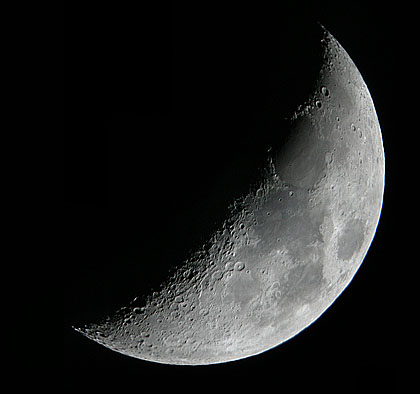
This is one taken through the higher magnification eyepiece.
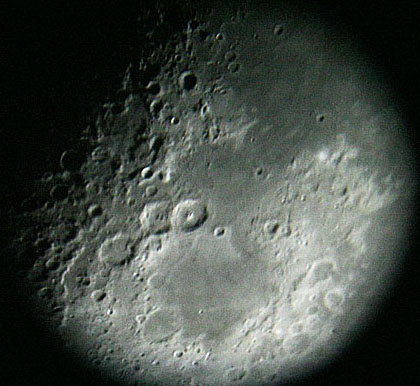
The peculiar guy who walks his dog down the street all the time stopped and took a look and asked questions about stars, the milky way, and Lowell Observatory. "oh yes, the Clark telescope at Lowell Observatory is much bigger than mine..." eheh.
I found M11 again and showed it to Giselle. She could make it out, and thought it was cool. But she was still highly interested in playing jailhouse warden games w/ me & Harrison and the red flashlight. After looking at it for a while, I decided I could see the loose shape of a duck taking off from the water...thus "Wild Duck Cluster" I guess. I also see faces in tortillas and clouds of smoke.
Next, I started scrolling South down the Milky Way, and found two fuzzies. The first was just south & slightly east of M11. I sketched the stars around it, and best I can figure, it's NGC 6712. As I was sketching it, a satellite cruised right through my view, which I thought was pretty cool. I haven't been able to figure out what the second fuzzball was. It was much further south. I couldn't make out more than a circular diffuseness on either one, especially due to all the glaring lights everywhere.
I ended up getting Giselle interested in the idea of sketching the layout of stars for later research. "We could be like scientists," she said, "and then go in and check what we found!" She sketched some stars she wanted to identify. But I'm beginning to discover this is difficult when the reference stars are all pretty dim, and blend in with everything else when I check the Sky program that came with the telescope.
The kids came in, and I decided I wanted to hunt for Neptune and Uranus, since they sit there and taunt me every time I open that Sky program. So I started with Neptune, even though it's the dimmest, because it's right next to a star in Capricornus. I figured that would make it easy, but it turned out to be pretty stinking hard for me. The star, Theta Capricorni, was difficult to find in the spotter scope. My confidence that I had even the right reference star was low enough that I sketched the vicinity, and the object I thought might be Neptune. And then I'll try to revisit it later and see if its position changes. It did appear to be blue-green...but that might just be my wishful thinking. Anyway, I'll see what happens....it looks that giving it a week or two would be enough to see a noticable change.
My next stop was Uranus. While it is brighter, it's also not next to a prominent constellation star. I used an imaginary line from a star in Aquarius (Lambda Aquarii) to a star in Capricornus (Delta Capricorni) and looked about a third of the way over from Aquarius. In this case, Uranus was supposed to be bounded very neatly by 4 bright stars including Sigma Aquarii. And there it was. I saw Uranus! It was ever so slightly greenish. And what's more, when I put in the 10 mm eyepiece, it wasn't a point of light anymore. It was a thick little dot. I checked my focus on the nearby stars to be sure I wasn't fooling myself, and they were all reasonably pointy points, but my planetary catch was a thick dot. MAN that's cool! I sketched it's position, compared to imaginary bisecting lines in the square of stars just to revisit later and double-check that it moved, but I'm positive that was it.
After that personal victory, I did some pleasure viewing of the Pleiades, and then Andromeda, before doing some window shopping starting in the Milky Way at Casseopeia. I just started looking for fuzziness in the spotting scope. And easily ran into 4 different DSOs. I sketched what I saw and referenced their position in the Milky Way relative to Casseopeia, the Pleiades, and Auriga for checking later.
The first one was a beautifully obvious double-cluster northeast of Casseopeia. It had a cool string of stars trailing away from it like a cast fishing line. This turned out to be NGC 884 and 869, The Double Cluster in Perseus. Awesome.
After grinning over that, I moved on and found another cluster near Lamba Persei. It was a bit looser than M11 or the double cluster I just saw. My sketch matched closely to NGC 1528 and I'm pretty sure that was it (there's two rows of three brighter stars in the middle).
The next patch I ran into was just inside Auriga, next to Iota Aurigae. It was another loose cluster when I checked it in the 25 mm eyepiece. My sketch matched up to M36,
My last stop was a rich cluster of stars just outside of Auriga, near Theta Aurigae. This one is dense like M11, and I had to sketch it with a rough outline, and then some main marker stars inside and out. It matched up to M37 in position and general configuration.
As I was writing this up, and checking the photographs I had taken, time passed quickly, and before I knew it, it was 4 am. So of course I popped outside and sure enough, Orion, Venus and Saturn were out. I took the telescope back outside and lined up on Venus first. With the 10 mm eyepiece, it was an incredibly brilliant half circle. In fact it was so bright, it was throwing flare all over the lens. Still, this was the first time I had seen Venus in anything other than binoculars, and it was impressive.
My next stop was Orion's belt. This was unbelievable. The M42 nebula is immense, bright, and peppered with hot stars. I could make out dust lanes and more detail than I thought I could from this spot (the neighbor's steenking driveway lights were still on :P ). Both 48X and 120X magnifications of nebula were bright and clear. This will definitely be one of my first DSO pictures when I get set up for long exposures.
Finally, I turned over to Saturn, which was glowing a soft ivory below Venus. 120X magnification showed the rings distinctly, but no Cassini division. Here's a crummy, blurry handheld shot for whatever it's worth:
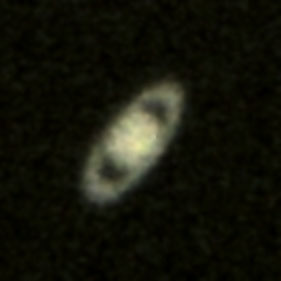
So my tally for the night: M11 (reprise), NGC 6712 (probably), M31 & M110 (reprise), M45 (reprise), NGC 884, NGC 869, NGC 1528, M36, M37, M42, M43, Neptune (probably), Uranus, Venus, Saturn and the moon.
This was great. I can't imagine what things would look like at a dark site. And I'm also looking forward to trying out astrophotography on them, as sort of a "See, I was there!" scrapbook.
Well that's enough geek for now.

After pulling that virtual all-nighter, I still managed to get up for our meeting Sunday morning. And then Amanda's sister Malanie, her niece Candice and her fresh new baby Sydney came up for a visit. Melanie, Giselle, Harrison and I drove over to Walnut Canyon and walked around the rim trail. We got there too late to walk the inner canyon trail and walk up to the ruins, but we could still see them peppered along the opposite wall.
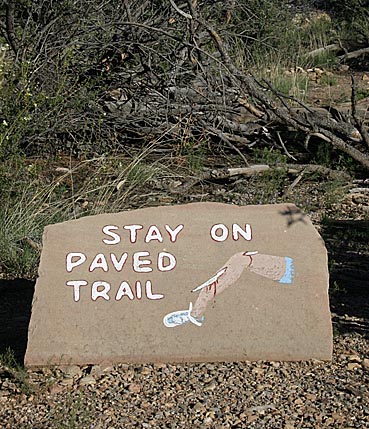
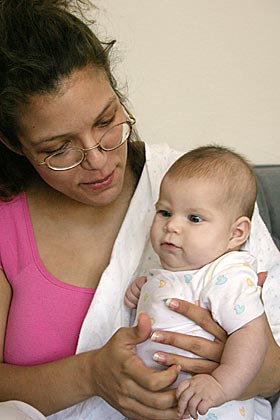
I'd also like to mention that I'm riding my bike to work a couple days a week again. This morning involved riding into a stiff headwind, which about tore the life out of me. The tailwind on the way home was nice though.
I'm outta here.
Posted by Jeremy at August 23, 2004 11:10 PM
